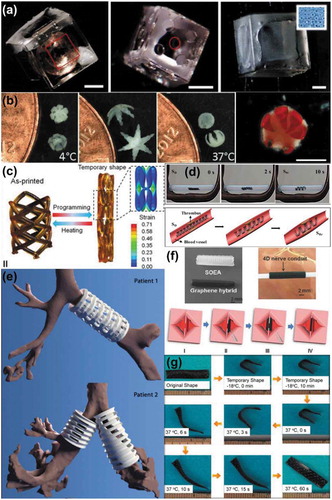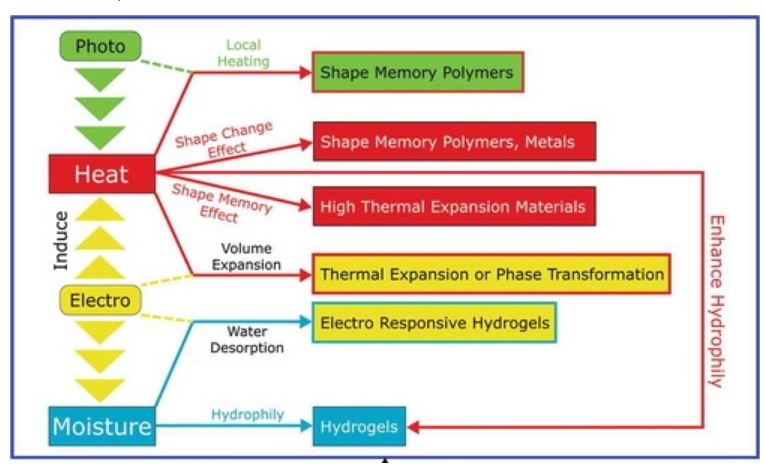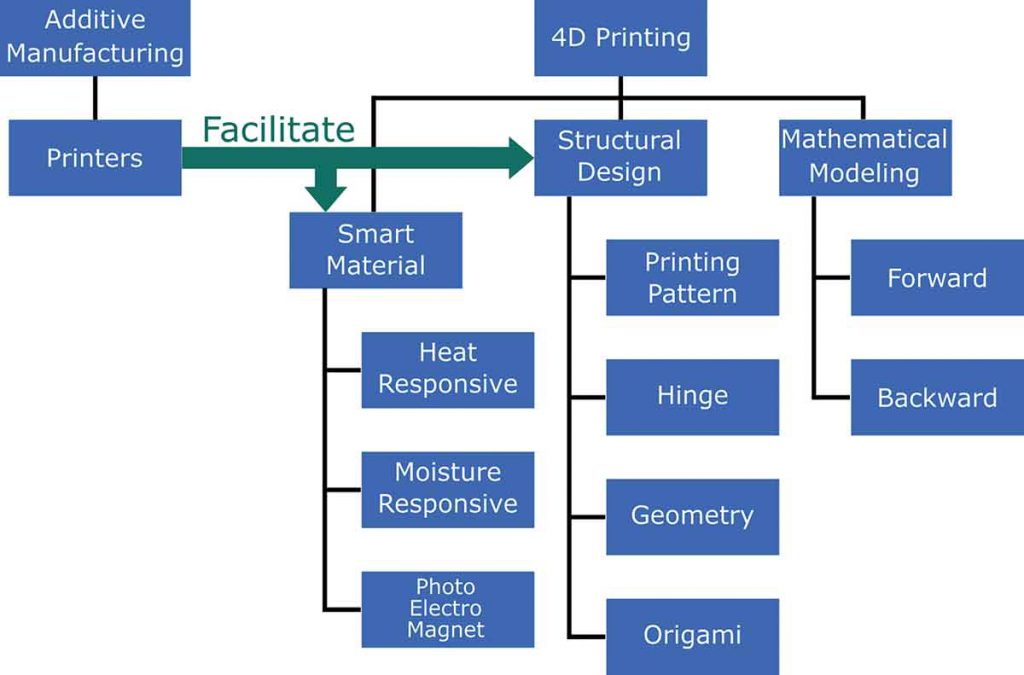 While 3D printing allows for many users to create complex geometries not before possible, 4D printing does that and more with materials and textures that respond to their environment and then revert to their original shape when exposed to other features like temperature. Zhizhou Zhang, Kahramen G. Demir, and Grace X. Gu (all from University of California, Berkeley) explore 4D printing and all its surrounding details in ‘Developments in 4D-printing: a review on current smart materials, technologies, and applications.’
While 3D printing allows for many users to create complex geometries not before possible, 4D printing does that and more with materials and textures that respond to their environment and then revert to their original shape when exposed to other features like temperature. Zhizhou Zhang, Kahramen G. Demir, and Grace X. Gu (all from University of California, Berkeley) explore 4D printing and all its surrounding details in ‘Developments in 4D-printing: a review on current smart materials, technologies, and applications.’
As the authors point out, 4D printing has continued to progress with further inventions in technique and materials. This gives it even more potential in applications like self-constructing structures, medical devices, and soft robotics, although there are still obstacles. FDM and SLA 3D printing are most commonly used for creating 4D objects made of metamaterials that can be flexible or cushioning as needed, good for products like lifters, microtubes, robotics, and toys too.
“To achieve directional shape change (contrary to trivial uniform swelling), the 4D-printed structure will consist of material anisotropy,” state the researchers. “This requires congruently printing a combination of multiple materials.”
Currently, the classes of materials being used in 4D printing are:
- Thermo-responsive
- Moisture-responsive
- Photo-responsive
- Electro-responsive
- Magneto-responsive
Self-construction structures are one of the most promising areas of 4D printing, with items such as self-folding cubes offering the potential for changing the world of packaging forever due to shape memory effect. Other important devices include self-rolled cylindrical tubes constructed with even distributed smart polymer grids.

4D-printed self-construction structures. (a) A self-folding cubic container printed from SMPs (b) A self-rolling tube container printed from smart polymers and actuated by acetone (c) A complex curved surface deformed from a flat state that was printed using moisture-responsive polymers (hydrogels) with a gradient distribution (d) A sequentially folded stipe that can lock itself. The joints are printed with different combinations of SMPs (e) Self-nested boxes whose joints are printed with SMPs in different colors (f) Cross-folding test specimens with and without a stress release hole (g) Conceptual design of a material with tunable lattice structure that permits bandgap control (h) Multifunctional material with tunable Poisson’s ratio.
“Smart materials can also be printed in a gradient distribution to allow researchers to control the surface curvature of a print,” state the authors in their paper. “This technology can greatly save space by fabricating structures as flat shapes. It is also capable of realizing complicated surface curvatures that are difficult to manufacture through traditional methods.”
One of the main benefits of 4D printing is in how it can control materials, with researchers continuing to make progress in this area. 4D printed materials are already being used in the medical field for devices such as prosthetics, implants, splints, stents, and even pharmaceuticals and targeted drug delivery. As 3D continues to be paired with robots—whether in making parts for them or in creating robots that can operate 3D printers—taking it to the next level in soft robotics with 4D printing is logical:
“Traditional robotics, primarily due to being made of rigid materials, have limitations in performing organic and compliant operations such as the grip of a human hand or the intricate motion of an octopus tentacle. Consequently, the field of soft robotics emerged in which certain soft materials, mainly special types of elastomers, are utilized as the interaction interface between robots and their environment,” state the researchers. “These soft materials allow for a gentle interaction with fragile objects and, when compared to traditional robotics, allow for a better tolerance towards damaging forces.”
Objects printed with complex geometries and no need for support structures or excessive post-processing procedures are made possible with some inkjet printing techniques also—allowing for the creation of durable actuators.
Current challenges in 4D printing are substantial though, including most hardware and materials, restrictions in mechanical properties, ‘slow and inaccurate actuation,’ along with insufficient control of varying phases of deformation.
“Advancements in printable smart materials, mathematical models, and printing technologies will allow for 4D-printing to further enhance surgical treatments, targeted drug delivery, soft robotics, and other unthought-of fields in engineering,” conclude the researchers.
The 4D realm continues to expand—and fascinate users everywhere—with innovations that not only form to their environments, but provide users and industry with exactly what they need in a wide range of applications whether for artistic endeavors, microfluidic structures, or seating for luxury vehicles. What do you think of this news? Let us know your thoughts! Join the discussion of this and other 3D printing topics at 3DPrintBoard.com.

4D-printed medical devices. (a) Photolithographically fabricated polymeric containers, intended for drug delivery, with different patterned porous faces outlined in red. (b) Thermo-responsive shape change demonstration of a theragripper. (c) 4D-printed stent (d) A 4D-printed magnetic stent (e) 4D-printed air-way splints that have been surgically implanted (f) A 4D-printed nerve guidance conduit (g) Shape memory demonstration of 4D-printed scaffold.

(a) Soft McKibben type actuator made from porous silicon elastomer with the pores filled with ethanol (b) Demonstration of 4D printed thermo-responsive liquid crystal elastomer used for adaptive optics (c) 4D-printed polylactic acid braided tube preform demonstrating thermo-responsive shape memory behavior as a gripper (d) 4D-printed SMP gripper (e) 3D-printed hydraulic robot using liquid support for bellow actuators.
Subscribe to Our Email Newsletter
Stay up-to-date on all the latest news from the 3D printing industry and receive information and offers from third party vendors.
You May Also Like
Profiling a Construction 3D Printing Pioneer: US Army Corps of Engineers’ Megan Kreiger
The world of construction 3D printing is still so new that the true experts can probably be counted on two hands. Among them is Megan Kreiger, Portfolio Manager of Additive...
US Army Corps of Engineers Taps Lincoln Electric & Eaton for Largest 3D Printed US Civil Works Part
The Soo Locks sit on the US-Canadian border, enabling maritime travel between Lake Superior and Lake Huron, from which ships can reach the rest of the Great Lakes. Crafts carrying...
Construction 3D Printing CEO Reflects on Being Female in Construction
Natalie Wadley, CEO of ChangeMaker3D, could hear the words of her daughter sitting next to her resounding in her head. “Mum, MUM, you’ve won!” Wadley had just won the prestigious...
1Print to Commercialize 3D Printed Coastal Resilience Solutions
1Print, a company that specializes in deploying additive construction (AC) for infrastructure projects, has entered an agreement with the University of Miami (UM) to accelerate commercialization of the SEAHIVE shoreline...































